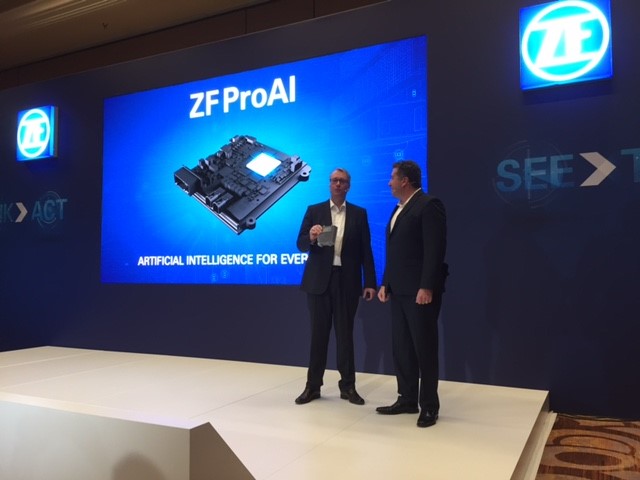Auto Parts Supplier ZF Launches 'ProAI' Self-Driving Solution Using Nvidia's Drive PX 2
At CES, ZF, one of the largest automotive parts supplier, launched its "ProAI" self-driving solution for vehicle manufacturers. The solution is based on Nvidia's Drive PX 2 computing platform for self-driving cars.
Nvidia’s Drive PX 2 Autocruise
ZF is the first tier 1 car parts supplier to use Nvidia’s Drive PX 2 system. However, Nvidia announced previously that the system is also powering Tesla’s Autopilot 2.0 hardware, which will be in newer Model S and Model X cars, as well as in the Model 3. It seems that the Drive PX 2 is already getting the seal of approval from important players in the autonomous vehicle market.
The Drive PX 2 computing platform is available in multiple configurations. The lower-end one, called Autocruise, includes a single Parker SoC, and it targets vehicles that only need to handle highway automated driving and HD mapping.
The Autochauffeur configurations comes with two Parker SoCs and two discrete Nvidia GPUs. The Drive PX 2 for Autonomous Driving (which Nvidia seems to differentiate from more general self-driving language) is a solution that includes multiple Drive PX 2 computers to enable full autonomous driving.
According to Nvidia, the ZF ProAI self-driving system is using the Autocruise, single Parker SoC computing solution.
ZF’s ProAI System
ZF’s ProAI will use Nvidia’s hardware to process information from different data-gathering sources that may be installed on self-driving vehicles, such as cameras, lidar, radar, and ultrasonic sensors.
“With NVIDIA, we are bringing the supercomputing power required for artificial intelligence into cars and commercial vehicles,” explained ZF CEO Dr. Stefan Sommer. “ZF is enabling vehicles to see, think and act. NVIDIA’s AI platform lets us take a giant leap forward when it comes to enabling vehicles – whether cars, trucks or forklifts -- to think,” he added.
Get Tom's Hardware's best news and in-depth reviews, straight to your inbox.
According to ZF, the system will be able to analyze the data in real time, locate itself precisely on the map, and plan a safe path forward. The solution will meet automotive-grade standards to function when exposed to extreme temperature, moisture, and dust.
The system is also capable of over-the-air updates, and it supports V2X (vehicle to anything) communications. Much like Tesla’s Autopilot, ZF said its ProAI system can learn from the whole network and ProAI-enabled vehicles to improve its self-driving accuracy.
Security Questions Linger
ZF hasn’t mentioned what security protections are in place to ensure that the over-the-air updates can only be done securely. As more such smart cars powered by mostly software appear on the market, chances are the interest in hacking them will also grow.
It would be better for vendors of autonomous driving solutions to tackle this issue early on, when they can still design security into their products, rather than later on when it’s harder to break compatibility and the systems are already in millions of cars.
The V2X communications, which allow cars to talk to other cars as well as to other sensors and technologies built into the infrastructure for cars, will also potentially be another attack vector. However, we won’t know for sure just how secure it is until we see it tested in the real world.
ZF wants to bring ProAI not just to self-driving cars, but also trucks, forklifts and other material handling vehicles that may need their own self-driving driving “brain.” The the mass production of ProAI systems will begin in 2018.
Lucian Armasu is a Contributing Writer for Tom's Hardware US. He covers software news and the issues surrounding privacy and security.
-
anbello262 I actually read the title as "Audio Part Supplier (...)" and was utterly confused for many seconds.Reply
I think this will have some nice uses in the industry.
